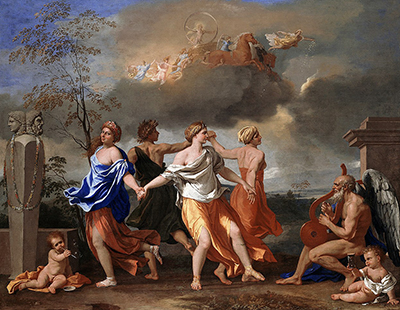A Dance to the Music of Time is an oil on canvas painted by Nicolas Pousin between 1634 and 1636. The piece was commissioned for Giulio Rospigliosi, who eventually became Pope Clement IX.
Four figures are depicted in the painting, each holding hands while they dance in a circle during the early hours of the morning. On the right side of the piece, Father Time plays a lyre. Two putti play with an hourglass and blow bubbles, representing the brevity of life. In the clouds above the dancers is Aurora, the goddess of dawn. She soars in front of a chariot guided by the sun-god Apollo, who is holding a ring representing the Zodiac. The Hours follow the chariot.
While the meaning of all the figures are not definitively known, seventeenth century Italian painter and artist biographer Gian Pietro Bellori suggested Rospigliosi dictated the artwork's elements. He also suggested that the four dancers represent Poverty, Labour, Riches, and Pleasure. Poverty is the bare-footed male figure at the back of the circle, with labour shown as a muscular woman to his right. Wealth looks with disdain at labour and is dressed in golden garments, while Pleasure smirks at the viewer. The dancers may represent the cycle of life, with pleasure eventually leading back to poverty. Others have suggested that they represent the four seasons.
A Dance to the Music of Time was originally inspired by Boitet de Frauville's Les Dionysiaques. It also illustrates the seasons and the passing of time. As Poussin created his work, the theme evolved into a greater focus on fortune and the cycle of life. The painting was created during a time of transition for Poussin, between his early work and a more mature period. It features the bright palette and warmth that dominated his early work during the late 1620s and early 1630s. At the same time, the painting has a more classical feel of Poussin's later work. For example, the movement and positions of the dancers are influenced by ancient Greek and Roman poses.
The painting is part of the Wallace Collection in London. Previously it was held with the Rospigliosi family until it was passed on to the Joseph Fesch collection in 1806. In 1845, Richard Seymour-Conway, the Fourth Marquess of Hertford, purchased the painting. His son, Sir Richard Wallace, inherited the painting. Poussin also made drawings of many of his paintings to prepare, including A Dance to the Music of Time. The only known drawing for this masterpiece is found in storage at the Scottish National Gallery of Art.




